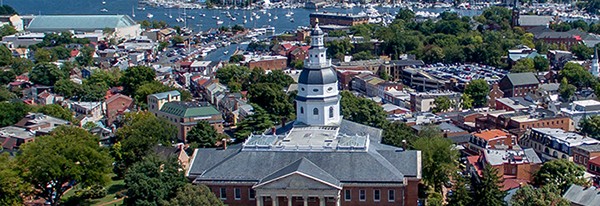Date:
Source: Capital Gazette, Danielle Ohl
Mayor Gavin Buckley on Wednesday said a meeting with the governor’s office proved “pretty positive” for a potential deal to hand over a waterfront landmark to the city.
If the state sells the Capt. William H. Burtis house to the city, it would give Annapolis control over the current home of the National Sailing Hall of Fame and an essential piece in the revitalization of City Dock. Gov. Larry Hogan’s administration will have to authorize the sale, which could include restrictions on use.
Buckley spoke at a Wednesday night meeting of the City Dock action committee, tasked with taking the findings of the Urban Land Institute’s recent study and creating short and long-term action the city can take. The action committee comprises Buckley, Alderwoman Elly Tierney, chair Eileen Fogarty, Historic Annapolis board member Bill Kardash, Historic Annapolis president Robert Clark and Historic Annapolis staff Karen Theimer Brown and Ron Jarashow.
It also includes nine subcommittees on various downtown issues, including design, financing, community programming and maritime access, made up of more than 75 volunteers.
The study recommends retaining the Burtis House in its current location, but expanding and repurposing the space for a maritime museum or city offices. Buckley has long-stated his wish to relocate the Harbormaster’s office to the historic waterman’s home. But the report, a result of two days of interviews with residents, lawmakers and business owners, also tackles flooding, walkability and parking among other development challenges.
The city and nonprofit Historic Annapolis created the action committee to study the findings and expand on the recommendations with specific action items.
Eileen Fogarty, a former city planning and zoning director, lead the group Wednesday. She identified some of the problems plaguing the Annapolis waterfront — dilapidated alleyways and sidewalks, lack of green space — but put them in perspective.
“There was an article in the Sunday New York Times about Baltimore,” she said. “You finish reading this article and you say, ‘Oh my gosh, we have no real problems,’ because we don’t … These are all solvable problems.”
Separated into issue-specific groups, the nearly 100 volunteers huddled around tables at the Pip Moyer Recreation Center to come up with preliminary opportunities and challenges. Each group will, by the end of May, present the committee with five actions to improve City Dock in the next six to 12 months and five actions to improve City Dock in the next five years.
The action committee will compile final recommendations by October with an end goal of creating a more accessible, enticing City Dock. The full committee will meet at least four more times before October.
In conversations, the working groups chatted about everything from insufficient parking technology to waterfront walkways to keeping water clean during extreme floods.
At one end of the room, the Programming/Community Access group talked about the walkway around Ego Alley, or lack thereof.
Chris Haley, leaning over an aerial map of City Dock, pointed to the back corner of the Annapolis Waterfront Hotel. A statue of Haley’s uncle sits at City Dock, “Roots” author Alex Haley.
“I stop right here,” Haley said. “I don’t even think I can get that far out,” noting there’s no continuous loop residents can take to get back to the other side of the water.
Across the room, the Parking/Pedestrian/Bike Connections group talked about tapping the city’s contracted parking management firm, SP+, to collaborate on technology to identify open spaces and vary pricing based on realtime demand.
Near the front of the room, the Financial Tools/Development table pointed to different locations the city could leverage to create more parking. Near the back, business owners on the Business/Property Owners & Retail discussed pop-up events and the need for an “anchor” store to pull shoppers toward the water.
Around the room were large, glossy posters of famous waterfronts around the country — Spruce Street Harbor Park in Philadelphia, the Chicago Riverwalk, Smale Riverfront Park in Cincinnati — all examples of the attraction City Dock can become.


